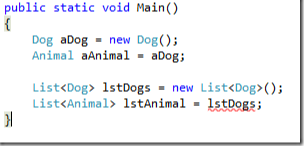逆变和协变,关键字在泛型接口和委托中使用
亲测:
Func<Object,Object> a = Func<string,string>;// ERROR,in不可协变 Func<string,Object> a = Func<string,string>;//Right,out可协变 //协变:out IEnumerable<string> strings = new List<string>(); IEnumerable<object> objects = strings; static string SetString(string o) { return "str"; } //逆变:in Action<object> actObject = SetObject; Action<string> actString = actObject; Func<string,string> funcString = SetString; //协变:out Func<string, object> FuncObject = funcString;//out协变
out,in泛型修饰符,泛型在声明的尖括号中<out T><in T>
out,in还可用作参数修饰符,在小括号中(),默认是in,ref侧重修改.out侧重输出。
out——协变
in——逆变
所以如果有一个泛型参数标记为out,则代表它是用来输出的,只能作为结果返回,而如果有一个泛型参数标记为in,则代表它是用来输入的,也就是它只能作为参数。
总之一句话,在泛型中,如果函数类型参数是只读或者只写,那么就可以使用协变或者逆变。如果类型参数无法保证只读或只写,这种类型参数(List)既不能协变也不能逆变,只能精确类型匹配。记住这个将是理解协变和逆变的关键。
下面是一些常用的泛型类或接口:
public interface IEnumerable<[NullableAttribute(2)] out T> : IEnumerable //List没有in和out修饰泛型,只能精确匹配,而不能逆变和协变。 public class List<[NullableAttribute(2)] T> public delegate TResult Func<[NullableAttribute(2)] in T, [NullableAttribute(2)] out TResult>(T arg); public delegate void Action<[NullableAttribute(2)] in T>(T obj);

想转化List为协变,需要以下操作:
List<Animal> lstAnimal2 = lstDogs.Select(d => (Animal)d).ToList();
List<Dog> 和 List<Animal> 是两个不同的类。是由泛型List<T>类型生成的两个不同类型。
java是同一个类,所以没有协变和逆变,List中的泛型是不变的【没有in 和 out】。
协变——返回和输出out
逆变——输入,传入派生类照样可以操作不报错,in